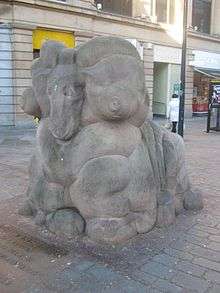The Derby Ram
The Derby Ram or As I was Going to Derby is a traditional tall tale[1] English folk song (Roud 126) that tells the story of a ram of gargantuan proportions and the difficulties involved in butchering, tanning, and otherwise processing its carcass.
Commentary
Llewellyn Jewitt wrote about the song in his The Ballads and Songs of Derbyshire of 1867, asserting that song had been alluded to for at least a century before that.[2] By some accounts, US President George Washington once sang "The Derby Ram" to the twin sons of Oliver Ellsworth, William Wolcott Ellsworth and Henry Leavitt Ellsworth (b. 1791), while staying at the Reeves - Wright mansion home in 1796 during one of his visits to Hartford, Connecticut.[3][4]
The song and the association of a ram with the town of Derby and used by a number of groups based there. In 1855, the First Regiment of Derbyshire Militia adopted a ram as their mascot and the ballad as their regimental song,[2] a tradition that continued into the 95th Derbyshire Regiment, and subsequently the Sherwood Foresters Regiment, Worcestershire and Sherwood Foresters Regiment, and Mercian Regiment, through regimental amalgamations.[5] Similarly, the football team, Derby County F.C. (nicknamed "The Rams") have taken the ram as their club mascot. There are a number of References to a ram throughout the architecture of Derby – perhaps the most notable is a large street sculpture on the junction of East Street and Albion Street by Michael Pegler.[6]
Traditional variations

The following version is the one transcribed by Llewellynn Jewitt in The Ballads and Songs of Derbyshire (1867).[2] RealAudio and MIDI versions of the tune can be found at this webpage (archived). The first three stanzas of this version are sung thus:
- As I was going to Darby, Sir,
- All on a market day,
- I met the finest Ram, Sir,
- That ever was fed on hay.
- Daddle-i-day, daddle-i-day,
- Fal-de-ral, fal-de-ral, daddle-i-day.
- This Ram was fat behind, Sir,
- This Ram was fat before,
- This Ram was ten yards high, Sir,
- Indeed he was no more.
- Daddle-i-day, etc.
- The Wool upon his back, Sir,
- Reached up unto the sky,
- The Eagles made their nests there, Sir,
- For I heard the young ones cry.
- Daddle-i-day, etc.
Helen Hartness Flanders collected versions of the song in both Shaftsbury and Springfield, Vermont, which featured an alternative nonsense-syllable refrain:
- As I was going to Derby
- Upon a markey day
- I saw the largest ram, sir,
- That ever was fed on hay.
- To di ro di do do,
- To di ro di da,
- To di ro di do do,
- To di ro di da.
- He had four feet to walk, sir,
- Her had four feet to stand,
- And every foot he had, sir,
- Covered an acre of land.
- To di ro, etc.[7]
An alternative recording of the song is found on the Derbyshire Folk and Dialect Vinyl LP "Ey Up Mi Duck, A celebration of Derbyshire. This version was recorded by Derbyshire-based Folk group Rams Bottom in the 1970s. Unlike many traditional variations, this version contains a narrative refrain:
- As I was going to Derby,
- All on the market day,
- I spied the finest ram, sir,
- That ever was fed on hay,
- And indeed me lads,
- It's true me lads,
- I never was known to lie,
- If you'd have been to Derby,
- You'd have seen the same as I.
- This ram it had a tail, sir,
- It was too long to tell,
- It stretched rate ovver to Ireland,
- An' it rang St.Patricks bell,
- And indeed me lads, etc.
Other renditions
The song was adapted by the English composer John Wall Callcott (1766–1821) into a 3 part glee "As I was going to Derby".
Merle Travis recorded a version of the song which was called Darby's Ram.
The Kossoy Sisters also recorded a version titled The Darby Ram on their 1956 album Bowling Green.[8]
British folk rock band Erland and the Carnival released a version of the song on their 2010 self-titled album, changing the lyrics to refer to a suicide which occurred in Derby in 2008.[9]
Sweeney's Men released a version of the song as a single - The Old Maid in the Garrett / Derby Ram (1967) -- Pye 7N 17312 [10]
also available on The Legend of Sweeney's Men : Anthology 2004 [11]
The New Christy Minstrels released an adaptation based on the Darby Ram, "Down to Darby" on their 1963 album The New Christy Minstrels Tell Tall Tales! (Legends and Nonsense)[12]
The song features as a sea shanty sung by pirates in the video game Assassin's Creed IV: Black Flag
References
- Post, Jennifer C. (2004). Music in Rural New England: Family and Community Life, 1870–1940. Durham, New Hampshire: University of New Hampshire Press. pp. 126–9. ISBN 1-58465-415-5.
- http://www.folkplay.info/Texts/86sk--lj.htm The Derby Ram, 1867
- William Garrott Brown, 1905, The life of Oliver Ellsworth, p. 233-234.
- Caroline Card Wendt, 1978, Discourse in ethnomusicology: essays in honor of George List, p. 122.
- http://www.wfrmuseum.org.uk/mascot.htm Mascot, 1867
- http://www.derby.gov.uk/Environment/PublicArt/DerbyPublicArtworkSeries-DerbyRam.htm Local Government Site
- Flanders, Helen Hartness; Brown, George (1968). Vermont Folk-Songs and Ballads. Hatboro, Pennsylvania: Folklore Associates, Inc. pp. 100–2.
- "The Kossoy Sisters". 11 September 2011. Retrieved 18 April 2014.
- Hughes, Rich (28 January 2010). "TLOBF Interview :: Erland & The Carnival". The Liner of Best Fit. Retrieved 4 May 2013.
- "The Old Maid in the Garrett / Derby Ram". 1967.
- "The Legend of Sweeney's Men". 2004.
- "The New Christy Minstrels". Retrieved 18 April 2014.
External links
- The Derby Ram, 1867
- Derby Ram lyrics and audio, archived from the original.
- . YouTube link to "Down to Darby" a spin off by the New Christy Minstrels